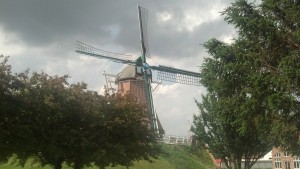
This Archer Daniels Midland coal storage facility in Clinton, Iowa, is hard to miss. (Photo by Michael E. Grass)
CLINTON, Iowa — There are two ways to cross the Mississippi River heading west on the Lincoln Highway from Illinois into Iowa. U.S. 30’s Gateway Bridge, a suspension span, provides a faster way through the area. But it skips Fulton, Ill., the town where the Lincoln Highway previously crossed on a bridge dating to 1891, later torn down and replaced.

The Windmill Cultural Center in Fulton, Ill., sits adjacent to the town’s Mississippi River levee. (Photo by Michael E. Grass)
Today, there’s a giant Dutch-style windmill that sits atop Fulton’s Mississippi River levee at the foot of 10th Avenue at 1st Street, where a the Windmill Cultural Center is located. Dutch settlers originally came to this spot along the Mississippi in 1835. Many more, including members of the Dutch Reformed Church, started coming in higher numbers in the 1870s. (The city hosted its Dutch Days in May.)
Today, you can take the 1970s era Mark N. Norris Bridge to connect with U.S. 67 to head into the heart of Clinton, formerly the “Lumber Capital of the World,” and link back up with U.S. 30 to head west. (My hometown, Grand Rapids, Mich., is the “Furniture Capital of the America.”) Clinton’s Sawmill Museum is on Grant Street, along Clinton’s Mississippi River levee.
Sawmills in Clinton processed lumber that came downriver from Minnesota and Wisconsin along the Mississippi. That processed lumber was then taken by rail to Chicago and points east, or to points farther downriver. But Clinton’s lumber boom went bust in the 1890s.
